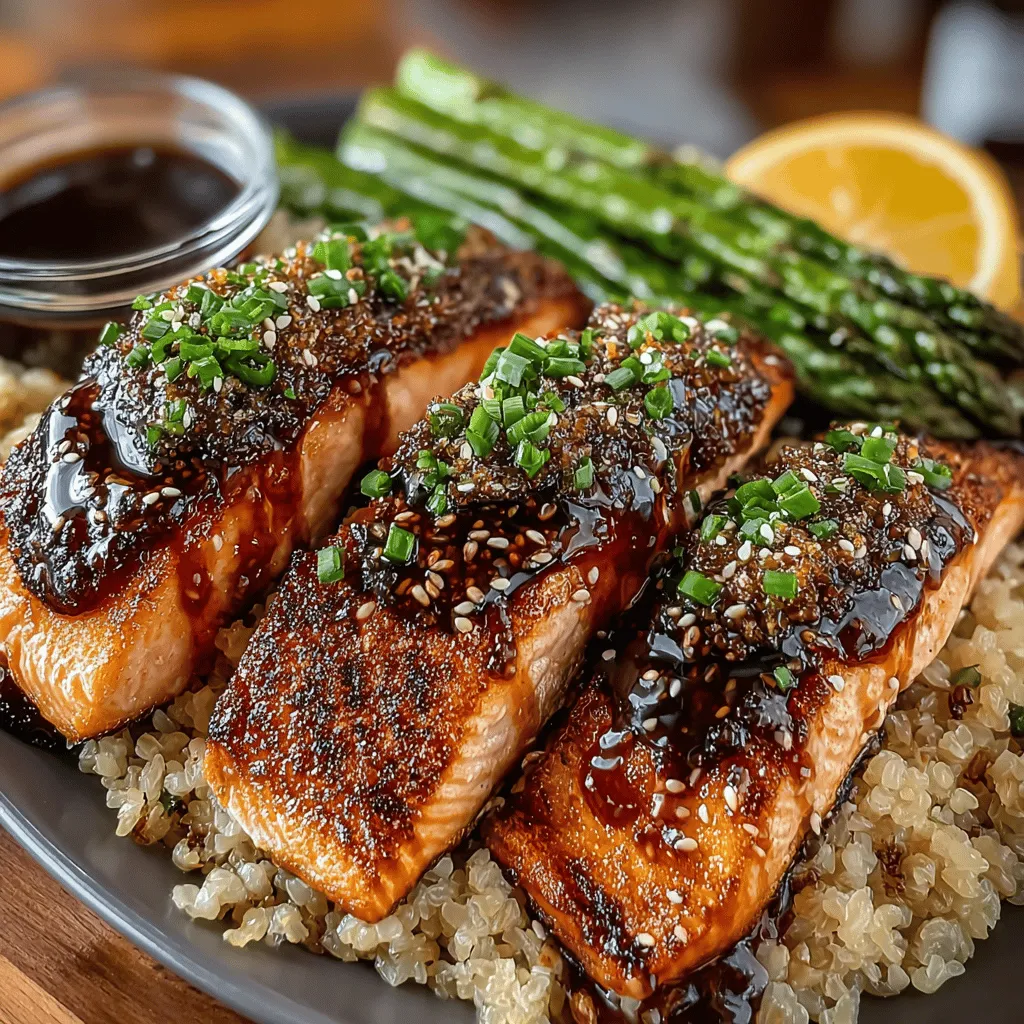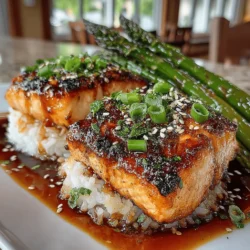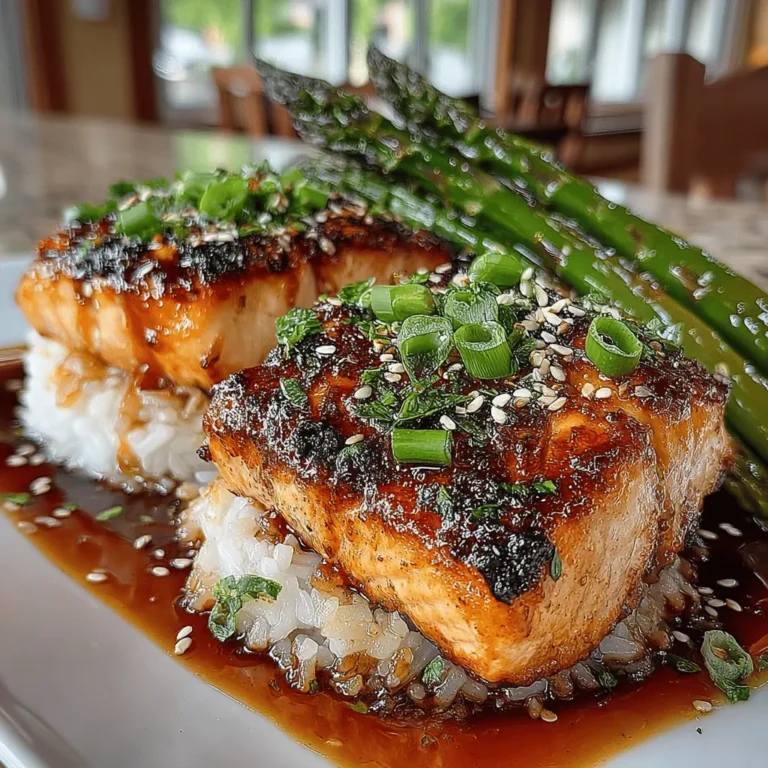Glazed Teriyaki Salmon with Asparagus Delight is a dish that perfectly balances savory and sweet flavors, making it a favorite among seafood lovers. The rich, umami taste of teriyaki sauce complements the tender, flaky salmon, while the bright, crisp asparagus adds a refreshing contrast. This dish is not only delicious but also offers numerous health benefits, as both salmon and asparagus are packed with nutrients. In this article, you will find a comprehensive recipe along with tips on selecting the best ingredients, preparing them properly, and cooking a complete meal that is as wholesome as it is satisfying.
Ingredients
– 4 salmon fillets (6 ounces each)
– 1 cup teriyaki sauce (store-bought or homemade)
– 1 pound fresh asparagus, trimmed
– 2 tablespoons olive oil
– 1 teaspoon garlic powder
– Salt and pepper to taste
– 1 tablespoon sesame seeds (optional, for garnish)
– 2 cups cooked brown rice (for serving)
Instructions
1. In a shallow dish, place the salmon fillets and pour the teriyaki sauce over them. Marinate for at least 30 minutes in the refrigerator.
2. Preheat your oven to 400°F (200°C).
3. On a baking sheet, arrange the marinated salmon fillets and asparagus. Drizzle olive oil over the asparagus and sprinkle with garlic powder, salt, and pepper.
4. Bake in the preheated oven for 12-15 minutes or until the salmon flakes easily with a fork and the asparagus is tender.
5. While the salmon and asparagus are baking, prepare the brown rice according to package instructions.
6. Once cooked, serve the salmon and asparagus over a bed of brown rice. Drizzle any remaining teriyaki sauce from the baking sheet over the top, and garnish with sesame seeds if desired.
The Essence of Teriyaki: A Flavorful Marinade
Teriyaki sauce is a traditional Japanese marinade that combines soy sauce, sake, mirin, and sugar. This rich, slightly sticky sauce provides a delightful balance of sweet and savory flavors that enhances the natural taste of the ingredients. Originating from Japan, teriyaki has gained popularity worldwide, often used for grilling and glazing various proteins. You can choose between store-bought teriyaki sauce for convenience or make your own at home to control the flavor profile and ingredients.
Choosing the Right Salmon for Your Dish
Selecting fresh salmon fillets is crucial for achieving the best flavor and texture in your dish. There are several types of salmon available, including Atlantic and Pacific varieties. Atlantic salmon is known for its rich flavor and higher fat content, while Pacific salmon, such as sockeye or coho, offers a more robust, distinct taste. When purchasing salmon, look for bright, moist fillets with a fresh ocean scent. Additionally, consider sourcing sustainable seafood to support environmentally responsible fishing practices.
The Nutritional Benefits of Salmon and Asparagus
Salmon is renowned for its health benefits, particularly its high content of omega-3 fatty acids, which are essential for heart health and brain function. It is also a great source of protein, vitamin D, and B vitamins. Asparagus, on the other hand, is a nutrient-dense vegetable packed with vitamins A, C, E, K, and various minerals, including folate and iron. With its high fiber content, asparagus supports digestive health and can aid in weight management. This dish, combining both salmon and asparagus, offers a well-rounded meal that fits perfectly into a balanced diet.
Preparing the Ingredients: A Step-by-Step Guide
To maximize the flavor in your Glazed Teriyaki Salmon with Asparagus Delight, proper preparation of the ingredients is essential. Start by marinating the salmon fillets in teriyaki sauce, allowing the flavors to penetrate the fish. The marination time can vary from 30 minutes to several hours, depending on how intense you want the flavor.
For the asparagus, ensure you trim the tough ends before cooking, as this part can be woody and unpleasant to eat. A simple snap of the asparagus will naturally break off the fibrous end. Cooking asparagus to the right tenderness is crucial; it should be bright green and still slightly crisp to maintain its flavor and nutritional value.
By following these steps, you will set a solid foundation for an exquisite meal that showcases the deliciousness of glazed teriyaki salmon and fresh asparagus.
Cooking Brown Rice to Perfection
Brown rice is often chosen as a healthier alternative to white rice due to its higher fiber content and nutritional value. When cooking brown rice, it’s important to rinse it under cold water first to remove excess starch, which can make the rice gummy. Use a ratio of 2 cups of water for every cup of brown rice. Bring the water to a boil, then reduce the heat to low, cover, and simmer for about 40-45 minutes until the rice is tender and the water is absorbed. This cooking process ensures that the rice retains its chewy texture while providing a wholesome base for your teriyaki salmon and asparagus.

Tips for Achieving Fluffy Rice Every Time
Cooking perfect rice is essential to accompany your Glazed Teriyaki Salmon. Here are some tips to ensure your rice turns out fluffy and delicious:
Rinse Your Rice
Before cooking, rinse your rice under cold water until the water runs clear. This removes excess starch, which can make your rice gummy.
Use the Right Water Ratio
A common ratio for white rice is 1 part rice to 2 parts water. For brown rice, it may be closer to 1 part rice to 2.5 parts water. Adjust based on the type of rice you use.
Let It Rest
After cooking, allow the rice to sit covered for about 10 minutes. This resting period allows the moisture to redistribute, resulting in fluffier grains.
The Art of Sautéing Asparagus
Sautéing asparagus is straightforward, but a few techniques can elevate its flavor and texture.
Techniques for Sautéing Vegetables
Start by heating a tablespoon of oil in a skillet over medium-high heat. Add the asparagus pieces and cook them without stirring for about 2 minutes, allowing them to sear and develop a nice color.
Ideal Cooking Time and Seasoning Tips
Asparagus typically takes about 4-6 minutes to become tender while still retaining a slight crunch. Season with salt and pepper, and consider adding a splash of soy sauce or a squeeze of lemon juice for added flavor.
How Sautéed Asparagus Complements the Teriyaki Salmon
The bright, slightly nutty flavor of sautéed asparagus pairs beautifully with the sweet and savory notes of teriyaki salmon, balancing the dish and providing a refreshing contrast.
Mastering the Salmon Cooking Technique
Cooking salmon to perfection requires attention to detail.
Techniques for Achieving Crispy Skin
To achieve crispy skin, start with a dry salmon fillet. Season it well, and place it skin-side down in a hot skillet. Avoid moving it until the skin is crispy, which usually takes about 4-5 minutes.
Importance of Cooking Times
Overcooked salmon can become dry. Aim for a total cooking time of about 8-10 minutes, depending on the thickness of your fillet. The salmon should flake easily with a fork when done.
Incorporating Garlic and Ginger for Maximum Flavor Impact
Adding minced garlic and ginger to your cooking oil when sautéing the salmon can enhance its flavor. Add them in the last minute of cooking to prevent them from burning.
Plating and Presentation: Making Your Dish Irresistible
Presentation can elevate your dish from good to great.
Tips for Plating Salmon and Asparagus Attractively
Place the salmon in the center of the plate, with the asparagus arranged artistically beside or underneath it. This creates a beautiful contrast of colors.
Suggestions for Garnishing
Garnish your dish with finely sliced green onions and a sprinkle of sesame seeds for added texture and visual appeal. A few lemon wedges on the side can also enhance the presentation.
Ideas for Enhancing Visual Appeal
Consider using a white plate to make the colors of the salmon and asparagus pop. A drizzle of teriyaki sauce over the salmon can also add a glossy finish.
Serving Suggestions: Pairing with Side Dishes and Drinks
To create a well-rounded meal, consider adding these side dishes and beverages.
Recommendations for Complementary Side Dishes
Steamed jasmine rice, a fresh cucumber salad, or a light Asian slaw pair beautifully with the teriyaki salmon. These dishes will complement the flavors without overpowering them.
Beverage Pairings
For a refreshing drink, consider serving a chilled glass of white wine, such as Sauvignon Blanc, which complements the dish’s flavors. Alternatively, green tea can enhance the meal’s Asian-inspired theme.
The Cultural Significance of Teriyaki in Cuisine
Understanding the background of teriyaki can enrich your dining experience.
Brief History of Teriyaki in Japanese Cooking
Teriyaki originated in Japan, where “teri” refers to a glaze or shine, and “yaki” means to grill or broil. It’s traditionally made with soy sauce, mirin, and sugar, creating a savory-sweet profile.
Discussion on Its Popularity in Western Cuisine
In recent decades, teriyaki has gained immense popularity in Western cuisine, often featured in various dishes, from rice bowls to fusion recipes, showcasing its versatility.
How Teriyaki Has Influenced Various Culinary Styles
Teriyaki has inspired countless adaptations, from teriyaki burgers to teriyaki stir-fries, influencing chefs to incorporate its flavors into diverse culinary styles.
Conclusion
In conclusion, Glazed Teriyaki Salmon with Asparagus Delight is not only flavorful but also packed with health benefits, including omega-3 fatty acids and vitamins from the asparagus. The preparation is straightforward, making it accessible for home cooks of all levels. We encourage you to try this recipe and experience the joy of cooking and sharing delicious meals with loved ones. Embrace the flavors and techniques, and make this dish a staple in your culinary repertoire.


